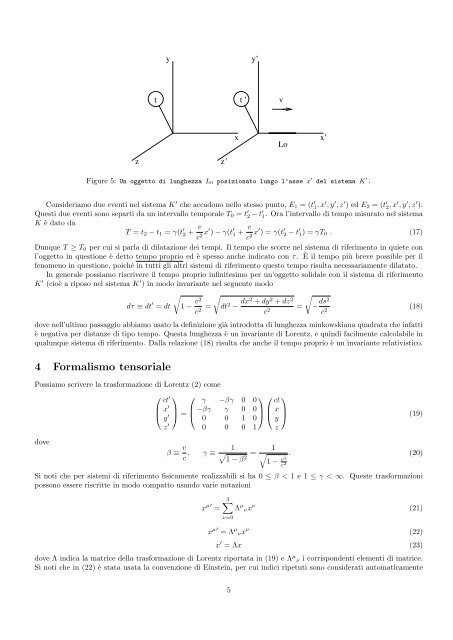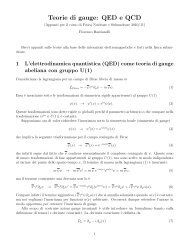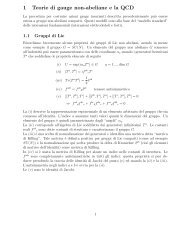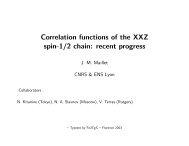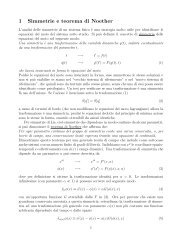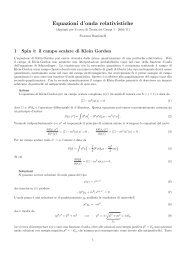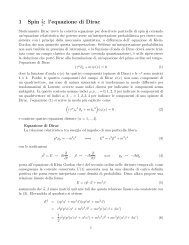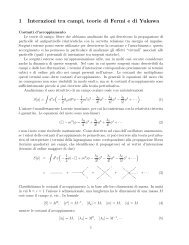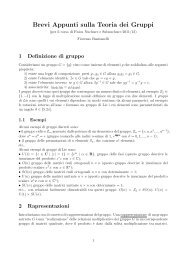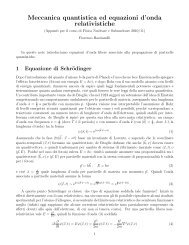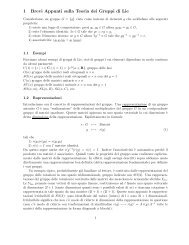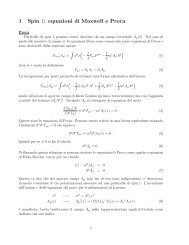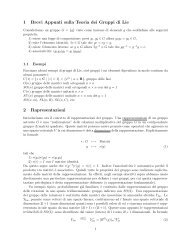Appunti di relatività ristretta
Appunti di relatività ristretta
Appunti di relatività ristretta
Create successful ePaper yourself
Turn your PDF publications into a flip-book with our unique Google optimized e-Paper software.
yy’t t ’vxLox’zz’Figure 5: Un oggetto <strong>di</strong> lunghezza L 0 posizionato lungo l’asse x ′ del sistema K ′ .Consideriamo due eventi nel sistema K ′ che accadono nello stesso punto, E 1 = (t ′ 1, x ′ , y ′ , z ′ ) ed E 2 = (t ′ 2, x ′ , y ′ , z ′ ).Questi due eventi sono separti da un intervallo temporale T 0 = t ′ 2 − t ′ 1. Ora l’intervallo <strong>di</strong> tempo misurato nel sistemaK è dato daT = t 2 − t 1 = γ(t ′ 2 + v c 2 x′ ) − γ(t ′ 1 + v c 2 x′ ) = γ(t ′ 2 − t ′ 1) = γT 0 . (17)Dunque T ≥ T 0 per cui si parla <strong>di</strong> <strong>di</strong>latazione dei tempi. Il tempo che scorre nel sistema <strong>di</strong> riferimento in quiete conl’oggetto in questione è detto tempo proprio ed è spesso anche in<strong>di</strong>cato con τ. È il tempo più breve possible per ilfenomeno in questione, poiché in tutti gli altri sistemi <strong>di</strong> riferimento questo tempo risulta necessariamente <strong>di</strong>latato.In generale possiamo riscrivere il tempo proprio infinitesimo per un’oggetto solidale con il sistema <strong>di</strong> riferimentoK ′ (cioè a riposo nel sistema K ′ ) in modo invariante nel seguente mododτ ≡ dt ′ = dt√1 − v2c 2 = √dt 2 − dx2 + dy 2 + dz 2c 2 =√− ds2c 2 (18)dove nell’ultimo passaggio abbiamo usato la definizione già introdotta <strong>di</strong> lunghezza minkowskiana quadrata che infattiè negativa per <strong>di</strong>stanze <strong>di</strong> tipo tempo. Questa lunghezza è un invariante <strong>di</strong> Lorentz, e quin<strong>di</strong> facilmente calcolabile inqualunque sistema <strong>di</strong> riferimento. Dalla relazione (18) risulta che anche il tempo proprio è un invariante relativistico.4 Formalismo tensorialePossiamo scrivere la trasformazione <strong>di</strong> Lorentz (2) comedove⎛ct ′ ⎞ ⎛⎞ ⎛ ⎞γ −βγ 0 0 ct⎜ x ′ ⎟ ⎜ −βγ γ 0 0 ⎟ ⎜ x ⎟⎝y ′ ⎠ = ⎝⎠ ⎝ ⎠ (19)0 0 1 0 yz ′ 0 0 0 1 zβ ≡ v c , γ ≡ 1√ = 1√ . (20)1 − β21 − v2c 2Si noti che per sistemi <strong>di</strong> riferimento fisicamente realizzabili si ha 0 ≤ β < 1 e 1 ≤ γ < ∞. Queste trasformazionipossono essere riscritte in modo compatto usando varie notazionix µ′ =3∑Λ µ νx ν (21)ν=0x µ′ = Λ µ νx ν (22)x ′ = Λx (23)dove Λ in<strong>di</strong>ca la matrice della trasformazione <strong>di</strong> Lorentz riportata in (19) e Λ µ ν i corrispondenti elementi <strong>di</strong> matrice.Si noti che in (22) è stata usata la convenzione <strong>di</strong> Einstein, per cui in<strong>di</strong>ci ripetuti sono considerati automaticamente5


